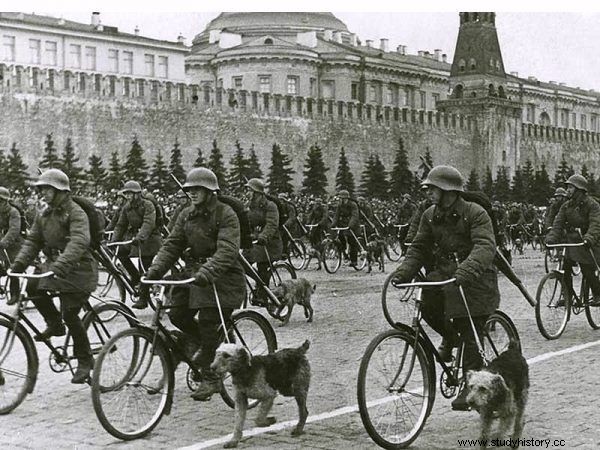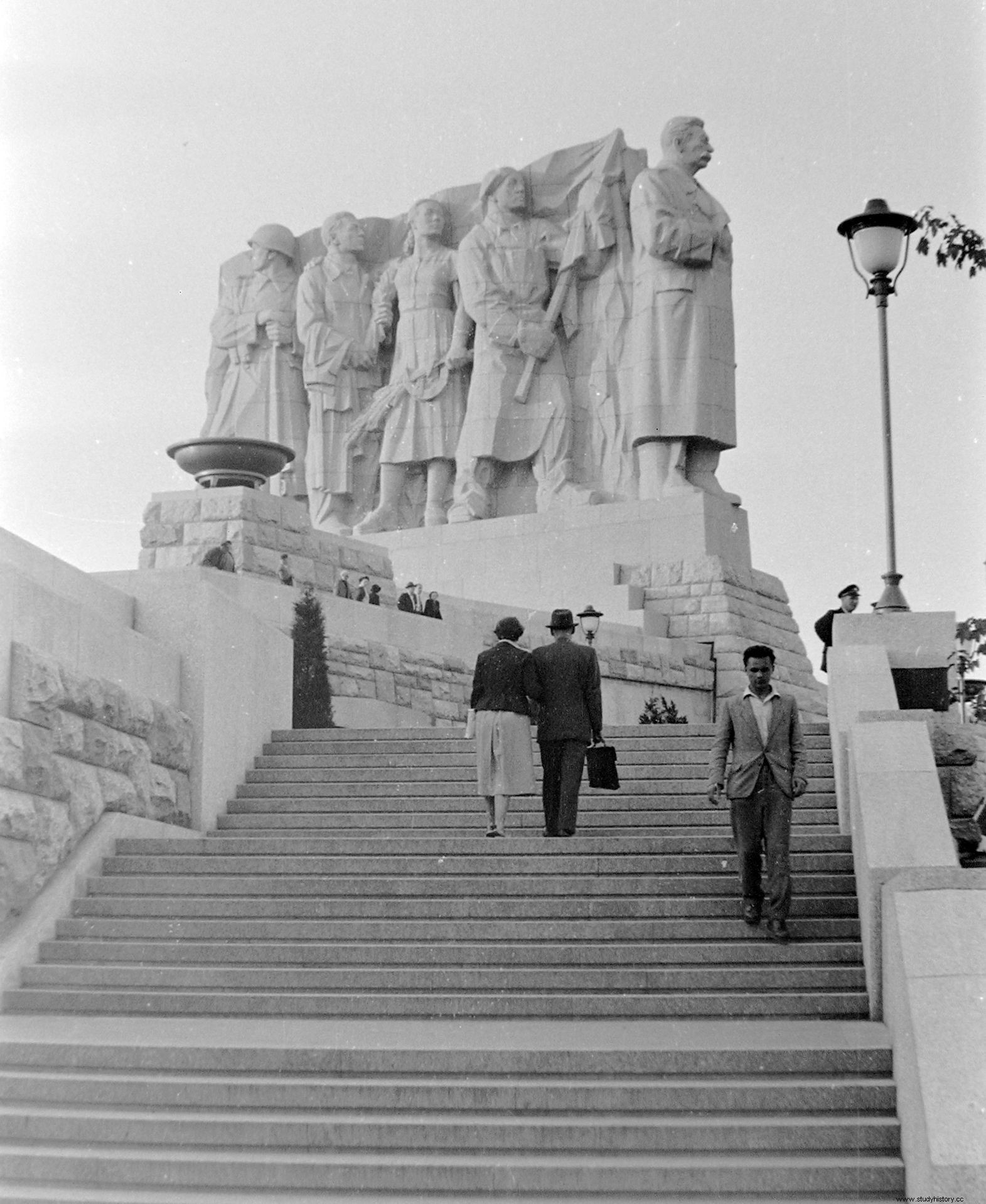There were only two streets in one Abkhazian town. One got the name:Stalin. The second - Dzhugashvili. The tyrant was demonstratively modest in the face of the cult's manifestations, but in fact he wanted to be considered the Messiah of the communist revolution.
One veteran of the Patriotic War recalled listening to Stalin's speeches on the radio: This was like listening to God's voice. And I dreamed of him as father . When there was a pause in the flow of words, the audience with a benevolent smile stated Oh please, Stalin is drinking .
The beginning of the cult is marked by the 50th birthday of the dictator (December 1929). And some of his symptoms were grotesque and absurd.
Kissing the holy image
Antoni Słonimski, who went to the USSR in 1932, noticed that Stalin's portraits were hung in every child's room in mother and child care facilities. The portraits were everywhere:in workplaces, offices, private apartments, on posters, in newspapers.
Someone noticed a huge ugly bust Stalin even in the exhibition of Rembrandt's paintings . In 1937, mountaineers carried another bust with them during an expedition to place it at a height of 7.5 thousand. meters. The sailors from the crew of an icebreaker placed the chief's portrait on the North Pole.
In towns and villages, the image of the leader often appeared where there was an icon until recently. In order to become a new God, the houses of the old God must be demolished - Kapuściński wrote. One citizen kissed a painting of Stalin in a public park.

Stalin's portraits were everywhere. One of them even had to accompany the Soviet delegation to Budapest in 1949 (Bundesarchiv, Bild 183-S94469, photo:Hermann, license CC-BY-SA 3.0).
In quasi-religious delight, the writer Leonid Leonov proposed to adopt a new calendar:the year of Stalin's birth (1879) would be the first. The dissident historian Anton Antonov-Owsiejenko later commented that since Stalin still believed that he was more popular than Jesus Christ, he graciously agreed to leave the calendar alone.
Stalinist Częstochowa rhymes
As a birthday present, Polish children sent a song: I'm a little child / I know Stalin's mind and deeds .
In Moscow, adult poets wrote little better poems. Alexei Tolstoy was delighted:
Oh you bright sunshine of nations
The non-setting sun of our time
And even more than the sun, because the sun lacks wisdom .
Another poet wrote in the “Czerwony Sztandar” newspaper, which appeared in Lviv:
Six sounds of your name
Shines like six radiant stars.
Folklore was also involved in this cult, as evidenced by, for example, the works of the Kazakh composer Jambul Jabayev. Stalin is deeper than the ocean, higher than the Himalayas, brighter than the sun. He is the teacher of the universe - proclaimed one of the poems published in "Prawda".
Everything in the name of Stalin
When my son is born, when he starts speaking, the first word he will say will be Stalin - the writer Awdieenko spoke. Because the very word "Stalin" has become an object of worship.
They were formed in the sky by fighters flying during parades. Gymnasts put their bodies into them during competitions. The name of the dictator in the USSR, as one researcher writes, two dozen cities, two oblasts, mountain peaks, a district of Moscow and the sea bay , not to mention industrial plants, kolkhoz factories or the Białomorski Channel.
There were two streets in Gagra, an Abkhazian town. One was given the name:Stalin, the other - Dzhugashvili…
Moscow bypassed similar honors - and Yezhov, after all, proposed in 1938 that it be renamed "Stalinodar". On the other hand, Stalinstadt appeared in the GDR, and Stalinvaros in Hungary. On the wave of the posthumous cult of the leader, Polish Katowice was temporarily called Stalinograd. Such a fate was supposed to meet Częstochowa earlier, but someone in time grabbed his head and decided that the vision of pilgrimages to "Our Lady of Stalinograve" was not very fortunate ...

In 1938 there was even an idea to rename Moscow as ... Stalinodar! The photo shows the May Day parade on Moscow's Red Square that year (source:public domain).
There was also - in opposition to the bourgeois Nobels - the Stalinist Prize. The Polish journalist wrote that while the Nobel Prize is the whim of a millionaire-inventor , it is these Stalinists that are accompanied by the name of the man who is the present, past and future of revolutionary humanity .
You clap or ten years
Stalin's speeches were released on gramophone records. There was one with nothing but applause on one side. This is easy to explain.
The famous researcher of Stalinism, Robert Conquest, cites a story from a provincial party meeting:the name of the dictator was mentioned and an ovation began.
Nobody dared to stop clapping first. When at last the old man, unable to stand any longer, sat down, his name was noted and the next day he was arrested .
We read about a similar story in Solzhenitsyn. The storm of applause continued for 11 minutes. Hands swelled, arms went numb, older people's legs bent. The director of the local paper mill allowed himself to be seated first - and was seated by the NKVD the same night. Sentence:10 years.

Here is Sra… Stalin in all his glory. Painting on the grass in Odessa (photo:Branson De Cou, source:public domain).
Quote faithfully and avoid typos
Everyone who had anything to do with publishing trembled under the Soviet rule. Typesetters and proofreaders have repeatedly wiped sweat from their foreheads, working hard to prevent a typo from slipping onto the columns - for example, "Sralin".
The whole nation had to repeat the wisdom of the leader, but you had to be very careful. For example, journalists commonly knew that Stalin's statements had to be quoted with all punctuation marks. For one abandoned mark one goes to the labor camp. Whole groups of people shook when quoting Stalin - this is a memory of Aleksander Wat.
Messiah or greatness described in three hundred ways
Propaganda kept finding new terms for the greatness of the leader.
Stalin was a "genius leader", "teacher of peoples", "the best kolkhoznik", "ensign of peace", "titan of thoughts", "coryphaeus of culture", and finally "a great linguist". The researcher of Stalin's cult in post-war Poland alone counted 336 such terms - the Soviet leader was literally "everything of everything".
Stalin knew music, so he could convince the composer Aleksandrov that his song was missing something. He sat down to the piano and immediately said: The second verse had to be moved to the end. How could we not notice it ourselves! . Stalin, of course, knew about the film, so he improved Piotr Pawlenko's script about ... Stalin's oath over Lenin's grave . One of the clues was: Lenin is to be John the Baptist, and Stalin - the Messiah .
Victims do not lose faith
Who knows if the most absurd aspect of Stalin's cult was in fact the zeal with which his victims professed the cult.
Bukharin, who was actually doomed, bowed down before him until the very end. The head of the security service, Abakumov, thrust into Lubyanka by Stalin, only borrowed his books from the rich library there . Long live Comrade Stalin! - General Jon Jakir, sentenced during the purge in the Red Army, shouted before the execution.
The cult of the bully-tyrant took its toll after his death - at the funeral, many people trampled themselves to death in hysteria. One of the students of the technical school in Gdańsk, who decorated the portrait of "the father of all Polish children" with crepe, died of a heart attack.

Even after the funeral, there were lines for the dictator's body. In the photo, people crowding at the entrance to the Lenin and Stalin Mausoleum in 1957 (photo:Manfred &Barbara Aulbach, license CC BY-SA 3.0).
Gigantomania or size is important
The cult was also associated with crimes against architecture. The Palace of Soviets, planned as the tallest building in the world at that time (over 400 m), was to be erected in Moscow on the site of the enormous Church of Christ the Savior. The palace was not built, but Kaganovich and Molotov managed to organize the blowing up of the church.
However, the peak achievement in this category was recorded in Czechoslovakia. Its authorities insisted on erecting a 12-story granite statue of Stalin in Prague, the tallest on Earth. The leader was leading a host of figures from worker to soldier to a bright future, and more courageous people joked that it was Stalin, whom everyone crawled into or the line for meat .
The monument was finished only after Stalin's death - to put it on a sand hill at all, it had to be reinforced with special concrete chambers. Party decision-makers honored the sculptor Otakar Szvec, who took his own life a month before the unveiling of "his" Stalin (he knew he was disgusting; besides, he was afraid of repression). His name did not even appear on the monument - it was announced that he was created by the "Czechoslovak People".

The greatest Stalin in the world (with a "meat train" behind his back) on the Prague hill Letná (photo:FORTEPAN / Szent-tamási Mihály, license CC BY-SA 3.0).
Indian chief or strange gifts
The closer it was to the 70th birthday of the "standard-bearer", the more gifts flooded in Moscow. Some were amazing. Azerbaijani weavers sent a carpet that they weaved for 70 days. The salt works in Aleksandrów Kujawski made a salt sculpture weighing almost a ton. Kompartia's delegate from Bulgaria brought a letter of thanks, which was signed by 5 million "Bulgarian working people", that is, probably all the adults in the country who could write.
The gifts also included Marx's "Capital" translated into ancient Hebrew and an ax from the Neolithic age. The real hit was the Indian chief's plume with a dedication to "the greatest warrior".
Modest Stalin and regained sight
How did Stalin react to all of this? Actress Lubov Orlova in her memoirs entitled "I loved Stalin" notes, for example: The cult was created not by him, but by various flatterers. Stalin did not like it very much .

Lyubov Orlova praised not only the commander's modesty. “I compared myself with Stalin and I was sincerely surprised - can I overwork myself? (…) Funny! Compared to Stalin, I was a real lazy. " In the photo of Orłowo in his dressing room at the Teatr im. The Mossovts. The photo is from the book "I loved Stalin" (Bellona 2016).
It is hard to be more naive. Stalin found the cult useful, and protested some of its symptoms demonstratively and deliberately. Who could say now that Stalin was not modest? One of the biographers wrote.
The cult (with its most absurd symptoms) did not end immediately after Stalin's death. However, after Khrushchev's famous speech, many previously blind communists in the USSR and beyond had to pour a bucket of cold water on their heads.
Some did not have to. Władysław Gomułka, who had just been released from prison, wrote maliciously in one of his epigrams:
When the "sun" went out and it's dark
The singers of its splendor regained their sight.
